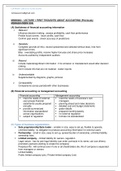COPYRIGHT (2019) 1ST CLASS ECONS
1stclassecons@gmail.com
MSIN0004 : LECTURE 1 FIRST THOUGHTS ABOUT ACCOUNTING (Previously
MSIN6004/MSIN1004)
(A) Usefulness of financial accounting information
i. Relevant
Influence decision-making : assess profitability, cash flow performance
Predict future events : future profits, cash flow
Confirm past events : check accuracy of predictions
ii. Reliability
Complete (provide all info), neutral (presented and selected without bias), free from
significant errors
Bias : overstating profits, receive higher bonuses and share price increases
Accounts audited by independent auditors
iii. Material
Include material/significant information : if its omission or misstatement would after decision
making
Don’t include info that are not material : clutter reports
iv. Understandable
Supplemented by diagrams, graphs, pictures
v. Comparability
Comparisons across periods/with other businesses
(B) Financial accounting vs management accounting
Financial accounting Management accounting
▪ meet the needs of external ▪ meet the needs of business’s own
user groups financial managers
statements usually prepared ▪ planning ahead and make decisions
annually ▪ detailed cost and budget statements
▪ provide summarized ▪ grater details
information standardized ▪ prepared monthly/weekly
across organizations ▪ no external regulation
▪ subject to regulation ▪ formats not standardized
(C) Types of business organizations
▪ Sole proprietorship/Sole trader – smaller in size, easy to set up, flexible to operate,
unlimited liability, no obligation to produce accounting information for external users
▪ Partnership – small in size, easy to set up, spread burden of ownership, unlimited liability,
ownership risks
▪ Limited company – limited liability for owners, regulation
Legal nature : has its own legal identity (can enter contracts in its name, can sue others),
promoters (persons wishing to create the company)
Perpetual life : will continue even if one or all shareholders die, life of company is separated
from managers or owners
Limited liability
Public limited company (plc), Private limited company (Ltd)
,COPYRIGHT (2019) 1ST CLASS ECONS
1stclassecons@gmail.com
(D) Business cycle concepts
➢ Gross profit : Revenue - costs
➢ EBIT/Operating profit : Earnings before interest and tax
➢ Net Profit : Operating profit – Interest
➢ PAT : Profit after tax/Profit for the year (Net profit – tax)
➢ Reinvested profit : PAT – Dividends
, COPYRIGHT (2019) 1ST CLASS ECONS
1stclassecons@gmail.com
L2-L4 Financial Framework
(A) Cash Flow statement
➢ Summarizes inflows and outflows of cash
➢ Layout/template of cash flow statement :
i. Cash flows from Operating activities
▪ Cash inflow : cash received from trade receivables, cash sales
▪ Cash outflow : operating expenses (rent, wages), tax, interest and dividends
ii. Cash flows from Investing activities
▪ Cash inflow : disposal of non-current asset, cash from financial investment
(dividends from shares in other companies)
▪ Cash outflow : acquire non-current asset, financial investment (loans made by
business)
iii. Cash flows from Financing activities
▪ Cash inflow : issue of shares, cash from loans
▪ Cash outflow : cash spent on buying back shares, repayment of loans
(B) Income statement/Profit statement
➢ Measure how much profit (wealth) a business has generated over a period. Flow of
wealth over a period of time.
➢ Profits :
▪ Gross Profit = Sales/Revenue – Cost of Sales/Cost of goods sold
▪ Operating Profit (EBIT) = Gross profit – Operating expenses/overheads
▪ Net profit = Operating profit – interest
▪ Profit after tax/Profit for the year = Net profit – tax
▪ Profit reinvested = Profit for the year – dividends
➢ Cost of goods sold/Cost of sales
Can be matched to individual sale at point of transaction (checkout machines)
Alternatively, COGS = Opening inventories + Purchases – Closing inventories
Depreciation
Depends on 4 factors : cost of asset, useful life of asset, expected redisual value,
depreciation methods
(a) Straight line method : applies fixed amount of depreciation to the NBV each year
Cost − Expected residual value = Depreciable base
Useful life of asset
❖ Constant depreciation expense each year
❖ NBV decreases by a constant amount each year
❖ Value at the end of useful life is zero





